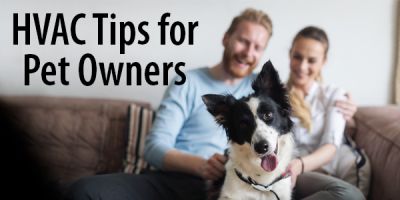
Having furry friends in your home signifies doubled responsibility when it comes to maintaining your HVAC system.
Owning a home is a huge responsibility, as is owning pets. So, while pets can be one of our best companions, having furry friends inside your home signifies doubled responsibility, especially when it comes to maintaining your home’s HVAC system. As lovable as our furry friends are, that fur comes along with dander, allergens, and shedding, which can all cause strain on your HVAC system if not properly maintained. However, there are many ways to keep the air in your home clean, making for a happy pet and a happy HVAC system.
1. Grooming
There are many beneficial reasons to regularly bathe and groom your pet – to promote healthy skin and fur, reduce shedding, and control allergens. Additionally, keeping your pet groomed regularly can be vital to maintaining your HVAC system. While the company of your beloved pets can be a wonderful thing, dogs and cats, unfortunately, can potentially cause problems with the heating, AC, and air quality of your home. Even with hypoallergenic breeds, all dogs and cats produce dander – some more than others. This is the leading cause of pet allergies in humans. Dogs and cats also accumulate pollen and dirt in their fur – particles which are major potential causes of allergies and reduced air quality. Pet fur, dander, and pollen can all contribute to dirty, overworked air filters, as well as impure air quality conditions.
If you are particularly concerned about the air quality in your home due to health concerns or other reasons, perhaps consider a hypoallergenic breed, which will produce significantly less dander and shedding. However, given that most cats and dogs are not hypoallergenic, regular grooming and bathing can help manage what your pet brings into your home. It’s recommended to bathe your dog approximately once a month, increasing or decreasing this amount based on your pets needs and habits (Be conscientious if you increase the amount you’re bathing your dog by using a gentle shampoo so as not to dry out or irritate your dog’s skin). Brushing your dog or cat is also a great way to keep them groomed and can greatly decrease shedding.
2. Clean Regularly
Owning pets means cleaning up after them – more than just the occasional accident they might have. Most dog and cat breeds shed, meaning, if you own a dog or cat, you will unquestionably have fur in every corner of your home. It’s important to be mindful about this and regularly vacuum or sweep. Pay close attention to corners where hair and dust can accumulate. Dog and cats, unfortunately, don’t have the courtesy of wiping their feet before entering a home as humans do. So, if your dog or cat frequently goes outdoors, know they will bring the outdoors back inside with them. Dirt and mud love to cling to their furry paws and underbelly, as does pollen or other pests. Aside from the positive psychological benefits of keeping a clean home, your HVAC system will greatly thank you as well.
3. Check and Change Filters Often
It’s always interesting to see what color your filters are based on the hair color of your pet. If you have a dog or cat who sheds, your air filters will unquestionably pick it up. While there are steps to take to reduce your dog or cat’s shedding, be aware that your filter is going to get clogged quicker than a home with no pets. A blocked air filter can reduce airflow and strain the system, so be mindful of that and check your filters at least once a month. More frequent filter cleaning/replacement will keep your HVAC system running smoothly.
4. Air Purifier
If you’re particularly worried about the air quality in your home, consider getting an air purifier. Consistent exposure to pollen, dust, dander, and other airborne particles can cause long term allergies and other breathing and health issues for you and your family. Those suffering from severe allergies or asthmatic issues might think that owning a pet isn’t an option for them. But an air purifier in addition to keeping your pet and home clean can help keep the air in your home clean, breathable, and safe. Your HVAC system will also appreciate the clean air.
5. Reconsider the Doggie/Kitty Door
Doggie and Kitty doors can be wonderfully convenient, no listening for your dog pawing at the door, no coming home during work to let your dog out, and no getting up in the middle of the night to let your pet out. While this can seem very practical, your energy bill may not look quite as nice. Part of standard HVAC system maintenance is finding and repairing air leaks and drafts to prevent straining your system. If you do decide to install a doggie/kitty door, or already have one installed in your home, make sure it’s properly caulked and sealed to prevent heat or cold from escaping your home.
6. Check for Exposed Wires or Other Exposed Hardware
As is the case with all home electronics, make sure no visible cables from your HVAC system are accessible to your dog or cat. Unfortunately, dogs don’t always understand the difference between their toys, your shoes, or exposed wires and cables. And while finding a ruined pair of your favorite shoes can be disappointing, exposed cables and wires can pose a serious hazard to your pet’s safety. Additionally, look out for other exposed hardware from your HVAC system, such as your condenser, which is likely to be located in the back or side of your house. Your dog is just as likely to mark the unit as they are their favorite tree, which can cause serious damage to your condenser. Instead of having to deal with repair bills, keep areas like this fenced off or inaccessible to your four-legged friend.